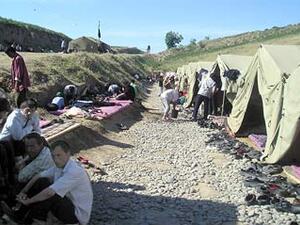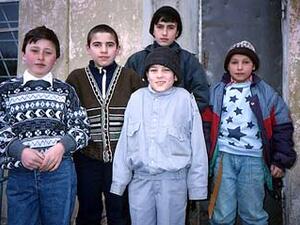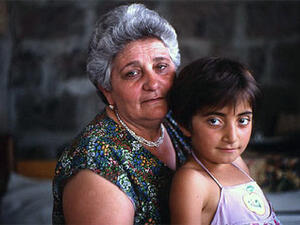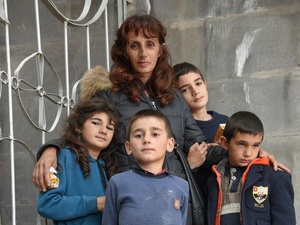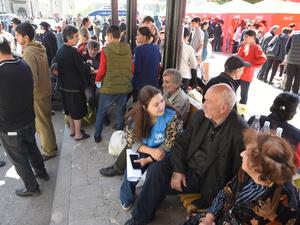My door is always open, says refugee in Armenia
My door is always open, says refugee in Armenia
Note: This story was lightly edited on 31 March 2006
YEREVAN, Armenia (UNHCR) - Destiny has come full circle and brought Sergey Danielyan back to his origins, to his ancestors' land where his life started.
Danielyan was born in 1936 in eastern Armenia. As a young man, he joined his brother in Azerbaijan's capital, Baku, where he worked as a driver and started a family.
In 1989 and 1990, tensions between the two countries over the disputed region of Nagorno-Karabakh triggered violence that resulted in the departure of Armenians from Azerbaijan's Sumgait and Baku. As ethnic Armenians, Danielyan and his family had to flee. But he wanted to go to Armenia while his wife decided to join her family in Brest, Belarus, taking their two daughters with her.
"I did not go with my family as I wanted to come back to my motherland," Danielyan explains. So he went alone to Armenia, where he was recognised as a refugee. In the beginning, he received some humanitarian assistance from the UN refugee agency, like food, clothing and other basic supplies. The Armenian Department for Migration and Refugees gave him shelter until he moved to his grandfather's old house in Shinuayr village, not far from Goris city in eastern Armenia.
Situated at the bottom of a gorge, the isolated village is accessible only on foot or donkey through a narrow road. It is completely cut off from the outside world once the rains start. Villagers gather in their garden during harvest time, but Danielyan is the only person who lives there permanently.
"I've done all the repair works myself," he says proudly to a visiting UNHCR team. "I planted new trees in the old garden. In addition I cultivate saplings, which I give for free to other villagers. Everybody likes and respects me. I don't even want to keep a dog, so that people can freely come to my place."

Sergey Danielyan near his home in the remote Shinuayr village in eastern Armenia.
At 69, Danielyan is cheerful and agile. He can easily climb trees, and walk to the upper village and look after his brother's garden. The earth there is stony and he has to carry the soil in a bucket. But he says it is not hard for him to do all this work alone. He is already used to it and feels satisfied with his way of life.
Although he lives alone - his daughters are working as a teacher in Belarus and a lawyer in the United States - he seems happy living with nature. Everything he needs is grown in the garden and he gives corn and cherries freely to everybody. "Let them take!" he booms, gesturing around the garden.
All passers-by stop and greet him or talk for a few minutes out of respect. Once a month, his relatives living in the upper village send him lavash (flat bread). His neighbours also bring him fresh milk and yogurt. "In principle, I don't need much, I eat very little. Fresh air and nature are quite enough for me," says Danielyan.
There's an Armenian saying that people living in harmony with nature become wise men. Danielyan is a living example of this. Despite his remote location, he is fully informed on current affairs around the world. He rattles off facts on the number of Russians living below the poverty level, on Russia's military pullout from Georgia, on the Baku-Jeyhan oil pipe line, and on relations between the government and opposition in Armenia.
"I don't need TV," he says. "It will not show anything here because of the weak signal. Instead I have a radio, which helps me to be aware of the situation in and outside the country."
Danielyan himself is a custodian of history - his garden is filled with ancient cross stones and pagan monuments. The most eye-catching item is a 3-metre-high cross stone with text engraved in ancient Armenian.
"When I was born, this cross stone was already here," he says. "People say that this cross stone was put up by [18th century Armenian national hero] David Bek. The specialists came from Yerevan and said that they were going to take it away to the museum. But its place is here and it should stay wherever our ancestors put it. That's why I cemented its base."
The village authorities call Danielyan "director of the open air museum". They even promised to pay him a salary, which he received just twice. Still, he continues to maintain these monuments without expecting any assistance or words of thanks.
"I am a person with a sincere heart and the doors of my house are always open to everybody," he says of his life credo.
Ethnic Armenians from Azerbaijan like Danielyan form the biggest group of refugees in Armenia today, numbering more than 230,000.
UNHCR opened its office in Armenia in 1992 to help the government meet the needs of more than 360,000 ethnic Armenian refugees from Azerbaijan who fled because of the conflict over Nagorno-Karabakh. The refugee agency and its partners have worked to provide humanitarian assistance for refugees, and permanent shelter for those living in temporary dwellings.
In recent years, UNHCR has focused on local integration, actively participating in the development of the refugee law in Armenia, and advising on how to facilitate the naturalisation of refugees. This means that refugees from Azerbaijan can simply apply for citizenship at the Armenian Social Protection Unit of the Department of Migration and Refugees, instead of having to live permanently in Armenia for several years in order to qualify for citizenship.
Some 62,660 ethnic Armenians from Azerbaijan have so far been naturalised in Armenia. Those who remain refugees live among the local population and have been included in the National Poverty Reduction Strategy paper along with other vulnerable Armenians.
This year, the Armenian government has allocated funds to solve some of the refugees' accommodation problems by providing housing purchase certificates in all regions of the country except Kotayk and Yerevan.
UNHCR continues to provide legal assistance to those refugees in need of protection, and produces bulletins and TV programmes to raise public awareness on refugee issues in the country.
By Rosa Minasyan
UNHCR Armenia

